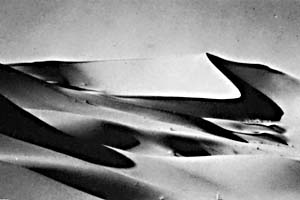Location 3
North Sahara, Algeria
The North of the Sahara boasts of a different type of sand dune which is the star dune. Single and complex barchanoid ridges, and megabarchans are also found, and it also has all the linear type dunes: simple and compound, feathered, with crescentic superimposed and with stars superimposed. Star dunes are a free dune, they have 3 or even more slip faces with multi directional orientations, as is the wind regime. They have a central peak with 3 or more arms.
The single and complex barchanoid ridges are rows of crescentic forms, with a unidirectional wind regime, and unidirectional slip- faces. They are again a transverse type of dune, forming by wave like motions in the wind. An explanation for the motions could be temperature gradient changes in the atmosphere. (Summerfield).
The region contains several large saucer shaped basins, plateau and highlands. Some of the basins contain extensive fields called sand seas or ergs. In Algeria the main erg is the Grand erg Occidental and Oriental. This covers most of Algeria.
 |
The Grand Erg Oriental from Algeria Source from NASA |
Hamadas are also found in the Algerian part of the Sahara desert. These are large elevated plateaus of rock. The Atlas Mountains found in the western part of Algeria and extending into the south of Morocco are examples of Hamadas.
The country of Algeria can be divided into 4 parallel bands running east west across the country. The fourth band in the country is the most southerly and it stretches from the Sahara Atlas Mountains covers more than 80% of the country. The temperature in the Sahara of Algeria at midday can exceed 55°C. Between November and February the Sahara's heat drops only slightly.
In the summer a hot and dry Saharan wind blows called the Sirocco. It travels northwards into the coastal cities, carrying the desert sand and dust with it.
In the Northern Sahara, which falls into Algeria, there are natural arches found in the desert which are formed due to wind action then wind erosion. The sand bodies would have been eroded by the constant wind and eventually would have been broken away to form the arch. Click on this link to view the natural arches found in Algeria.
http://www.cyberseek.com/nabs/gallery-Algeria-Sahara.htm
Beneath the gravel and the sand, the Algerian part of the Sahara hosts major oil and natural gas reservoirs which is why the country is one of Africans wealthiest.

